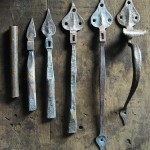What I Do
I took over the forge at Dent Smithy in 2006 after serving a 5-year apprenticeship training under an established blacksmith. Since then my work has been varied, ranging from small and intricate one-off fittings to larger-scale architectural installations and pieces of furniture. My special interest is in the employment of the age-old techniques of hot forge-work and find these can be applied as successfully to the design and construction of a pair of delicate cabinet hinges as to a contemporary garden gate, a traditional candelabra, a simple Suffolk latch, an elegant fire-screen or an ornate staircase or balustrade.
I do not practice these traditional techniques for nostalgia’s sake. While I absolutely believe that preserving a working knowledge of heritage crafts is culturally important, this is far from being the primary reason I work as I do. Instead, I use the coke fire and old-fashioned tools because modern, labour-saving devices cannot produce the same results. Metal that has been heated and forged (‘wrought’) with care and skill is quite different from metal worked in any other way; it has a quality, a look and feel, rarely achieved in cast, engineered or fabricated metalwork.
In this country, the popular image of ironwork is not a glamorous one. Many fine historical examples have been lost to us, carelessly preserved or stripped and melted down to be recycled (much was appropriated during times of war, when it was used for the production of armaments). As it is both useful and abundant, iron (most commonly in the form of steel, an alloy of iron, carbon and other elements) is easily taken for granted; valued for its many practical applications but overlooked for its almost limitless decorative potential. This is what I want, in my small way, to redress.
Consideration of the material with which they work always informs a craftmaker’s design decisions. Of course, when it is cold, steel is tough and solid, and we would be foolish not to take advantage of this strength and the benefits such qualities offer us, but when it is worked hot it becomes malleable, responsive and expressive. This is what makes working with it so fascinating to me, as with the help of the fire I am able to produce flowing, organic forms, fine tapers and intricate details in the knowledge they will cool and harden into hard-wearing, useful items, which are at once beautiful and practical. Good forged ironwork will be strong, firm and durable, but it can also look delicate, tactile and supple. Blacksmithing is not about beating and coercing a tough, uncooperative substance into submission, but about understanding and harnessing it’s many useful characteristics, respecting its limits and celebrating its versitility. This is what I try to do.
- Six stages of a Suffolk latch handle as it changes from blank stock to finished article

